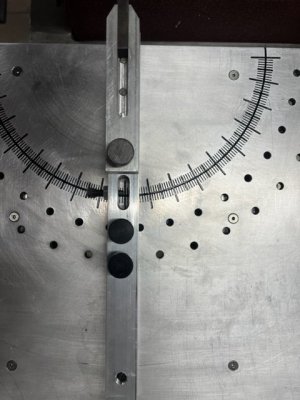Question for you smart-experienced guys

I ordered a .060" carbide end mill from McMaster. It has a 1/8" shank with a 1/2" length of cut.
I immediately realized I was running way too slow at 2,500 rpm. I'm hand feeding very slowly.
What RPM would you run? I can go as high as 4,800 but it's in the red zone on the mill. 3,000 is safe. Too slow?
The material is annealed A2. I already eased the cut by using a .032" slitting saw thinking this would help to not break the end mill

$35 down the drain. Grr$%^&*(!!
I know, why not use a slitting saw?? I just ordered a .062" from McMaster.
I want to learn from my mistake.
If you could enlighten me with any tips that come to mind you would make my day.
Thank you,
Jeff
I can't claim to be smart-experienced, but I did successfully cut an approximate 0.400" long by 0.0625" slot in a 1/8" thick O-1 using a 0.0625 end mill for an acquaintance twenty couple years ago. I was using a manual X2 minimill running around 4000 rpm. I took around 0.010" depth of cut at a time. I also predrilled each end of the slot first. I got lucky and did not break the end mill. I remember it to be an experience that I would not want to repeat. Very stressful.
If I had the wonderful machines in your list, I would make an trapezoidal shaped aluminum plate that would clamp onto the mill quill and on the small end, make clamping hole to accept a Proxxon IBS/E.
It has an aluminum nose perfect for clamping. It is very smooth running, unlike the Dremel hand vibrators I've used. Max speed is 20k rpm. On your part, I would cut away all but around 0.010" from the bottom and jam a shim in the cut slot, flip the part around and cut the remaining material starting in the through hole. The shim could prevent the slot springing shut and grabbing the end mill. And if it did, it would be easier to clean up the damage in the slot from the outside vs from in the clearance hole.
Or you can, depending on your max rpm of your lathe, mount the part on an angle plate attached to your cross slide. Put alignment blocks on the angle plate to aid in repositioning to cut the last 0.010" out of the bottom of the slot as in the above procedure.
Or if you can lock your lathe spindle, make a toolpost holder to mount the Proxxon IBS/E and cut the part on a face plate.
Or instead of the Proxxon IBS/E, use a toolpost grinder set up for ID grinding to hold the end mill.
I think the lathe cross slide would be easier to control than a mill table hand wheel / crank.
I would also don an Optivisor under a face shield to keep an eye on the chips in the slot.
Well those are my amateur suggestions for using an end mill.
In my modest shop, I would like you, use a 0.0625" slitting saw and cut almost through, re-orientate, pack a shim and carefully cut the small remaining material away.
It might be the lighting of the
end mill.jpg shot of your part, but it looks like your mill could be slightly out of tram.
Happy New Year,
Jeff



